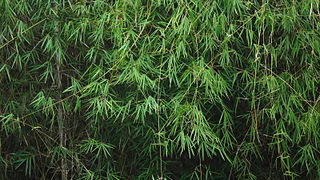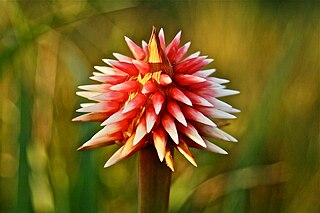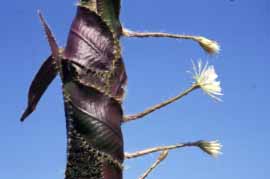
Gentiana is a genus of flowering plants belonging to the gentian family (Gentianaceae), the tribe Gentianeae, and the monophyletic subtribe Gentianinae. With over 300 species, it is considered a large genus. Gentians are notable for their mostly large trumpet-shaped flowers, which are often of an intense blue hue.

Oncidium, abbreviated as Onc. in the horticultural trade, is a genus that, as of December 2023, contains about 340 species of orchids from the subtribe Oncidiinae of the orchid family Orchidaceae. It is distributed across tropical and subtropical America from Mexico, Central America and the West Indies to northern Argentina, with one species (O. ensatum) extending into Florida. Common names for plants in this genus include dancing-lady orchid and golden shower orchid.

Anthocleista is a genus of tree- and shrub-like tropical plants in the subtribe Potaliinae in the Gentian family. There are between 14 and 16 species in the genus, native mainly to tropical Africa, including Madagascar and the Mascarene Islands. Anthocleista was once placed in the family Loganiaceae, but more recent molecular, morphological, and phytochemical evidence has placed the group well within the Gentianaceae.

Hevea is a genus of flowering plants in the spurge family, Euphorbiaceae, with about ten members. It is also one of many names used commercially for the wood of the most economically important rubber tree, H. brasiliensis. The genus is native to tropical South America but is widely cultivated in other tropical countries and naturalized in several of them. It was first described in 1775.

The genus Macrocarpaea, with 105 species and two hybrids of 0.5 m herbs, shrubs, epiphytes and small trees to 10 m tall, is the largest genus of the tribe Helieae of the gentian family (Gentianaceae). Species of Macrocarpaea have diurnal and nocturnal pollinators, visited during the day by hummingbirds, insects and butterflies, and at night by bats, moths and many different kinds of insects. The common name for the genus is 'Moon-gentian'. No species are known in cultivation.
Micrandra is a plant genus of the family Euphorbiaceae first described in 1854. It is native to South America.

Atractantha is a South American genus of bamboo in the grass family, native to Brazil, Colombia, and Venezuela.
- Atractantha amazonicaJudz. & L.G.Clark - Amazonas in Brazil, Amazonas in Venezuela, Vaupés in Colombia
- Atractantha aureolanataJudz. - Espírito Santo, Bahia
- Atractantha cardinalisJudz. - Bahia
- Atractantha falcataMcClure - Bahia
- Atractantha radiataMcClure - Bahia
- Atractantha shepherdiana – Athroostachys shepherdiana
Serranía de la Macarena is an isolated mountain range located in the Meta Department, Colombia. It was named after the Virgin of Hope of Macarena. The mountains are separated by about 40 km (25 mi) at their northern extreme from the East Andes. The range is orientated from north to south and is 120 km (75 mi) in length and 30 km (19 mi) wide. The highest peak reaches 2,615 m (8,579 ft) and is the highest point of the Orinoquía Region. The first national reserve in Colombia was established in the central part of the mountain range in accordance with a Congressional Law promulgated in 1948. The status of National Natural Park was designated in 1971 and the protected area encompasses 6,200 km2 (2,400 sq mi).

Couratari is a genus of trees in the family Lecythidaceae, first described as a genus in 1775. They are native to tropical South America and Central America.
Diacidia is a genus in the family Malpighiaceae. It comprises 11 species of trees, shrubs, and subshrubs. Ten species are found on the mountains of southern Venezuela and adjacent Brazil; one species is widespread in the drainages of the Rio Negro and the Río Vaupés in Venezuela, Colombia, and Brazil.

Vaupés River is a tributary of the Rio Negro in South America. It rises in the Guaviare Department of Colombia, flowing east through Guaviare and Vaupés Departments. It forms part of the international border between the Vaupés department of Colombia and the Amazonas state of Brazil. On the border it merges with the Papurí River and becomes known as the Uaupés. In 1847 an explorer saw a rapid which hurled its waves 12 or 15 metres in the air, "as if great subaqueous explosions were taking place." The river continues on east through the Alto Rio Negro Indigenous Territory until it flows into the Rio Negro at São Joaquim, Amazonas. Vaupés is a blackwater river.
Sequencia is a monotypic genus of plants in the family Bromeliaceae. The sole species is Sequencia serrata, endemic to the Vaupés region of Colombia.
Croizatia is a small genus of plants in the Phyllanthaceae first described as a genus in 1952. It is native to Panama and to northwestern South America. It is dioecious, with male and female flowers on separate plants.
- Croizatia brevipetiolata(Secco) Dorr - Colombia, NW Venezuela
- Croizatia cimaloniaCerón & G.L.Webster - Ecuador
- Croizatia naiguatensisSteyerm. - N Colombia, N Venezuela
- Croizatia neotropicaSteyerm. - N Venezuela, Vaupés in E Colombia
- Croizatia panamensisG.L.Webster - Panama, NW Colombia

Vallesia is a genus of plants in the family Apocynaceae first described as a genus in 1794. It is native to South America, Central America, Mexico, Florida, Galápagos, and the West Indies.
Duckea is a group of plants in the family Rapateaceae described as a genus in 1958.

Guacamaya is a group of plants in the family Rapateaceae described as a genus in 1931.
Monotrema is a group of plants in the family Rapateaceae described as a genus in 1872.
Hevea rigidifolia is a species of rubber tree in the genus Hevea, belonging to the family Euphorbiaceae. It is native to the rainforests of northern Brazil and Colombia, where it is endemic to localities near the upper Rio Negro, a north bank tributary of the Amazon River, and its tributary, the Vaupés River.
Hevea benthamiana is a species of rubber tree in the genus Hevea, belonging to the family Euphorbiaceae. A medium-sized deciduous tree growing to a height of about 27 m (90 ft), it is native to the rainforests of northern Brazil, Colombia and Venezuela.

Strophocactus wittii, synonym Selenicereus wittii, known as the Amazon moonflower, is a species of plant in the genus Strophocactus in the cactus family (Cactaceae), and is one of several species commonly called "moonflowers". It was first described in 1900 and is one of three species of cactus found in the central Amazon basin.











